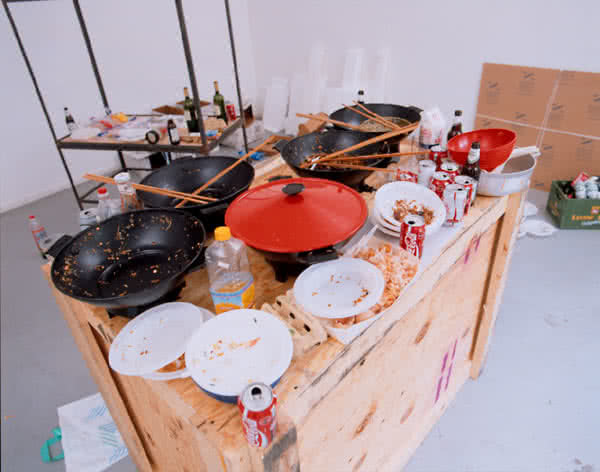
As I dove into the internet to find answers as to what Relational Aesthetics are (for weekly readings in CFI at school), I browsed the wiki page which wound up confusing me. From what I gathered, solely from the wiki page, Relational Aesthetics is a book by Nicolas Bourriaud about the modern art movement he has entitled ‘Relational Art‘; a practice that presents art as a representation of the entirety of human relations as a whole, rather than having an individual focus point in other forms of art. The only thing I can relate this to personally is the idea of a flash mob, in which a group of people gather together through their phones to perform a surprise dance or choreographed move that is viewed by a large number of people. Bourriaud says that
‘the audience is viewed more as community. Rather than the artwork being an encounter between a viewer and an object, relational art produces intersubjective encounters. Through these encounters, meaning is elaborated collectively, rather than in the space of individual consumption.’
…and I’m still confused. It seems to be a very hard thing to pin down, just exactly what Relational Art is, or does. Further internetting led to me to take a peek at some more links, which led to a documentary about Relational Art, done by Ben Lewis for BBC4. The site which hosts the video, UBUWeb, has a screenshot in the left corner of their website from Un Chien Andalou, which I thought was a nice piece of synchronicity to my earlier post.
Upon watching the documentary, the idea and concepts of relational aesthetics in art became more clear. Like all art movements, there are are many different levels that relational art can operate on, like dealing with the interactivity of the art, the functionality and usefulness of the art, and how ‘relative’ it is to a group of people or, to a lesser extent, the individual. It still, however, seems elusive, unable to completely describe itself, to summarize and get back to me with a solid idea of what it is, exactly, which is not a bad thing. I feel it’s just a symptom of youth of the movement, something all types of art must go through at some point.
A few quotes popped up during the documentary that caught my attention, the first being an excerpt from the short film about the concepts of relational-like art and its’ practice, Vicinato II.
‘My nightmare, is walking through the woods in the snow, surrounded by people pointing out how nice it is to be walking through the woods in the snow, with other people pointing out how nice it is to be walking through the woods in the snow….’
The meaning is unclear in the doco, but from what I can garner from the very brief discussion about it is that things like forests and nature have been preserved and protected to a point where its very safe and harmless, cleaned and sterilized (in the eyes of these particular artists). The nightmare comes from the other people feeling the need to bring attention to the fact that they are walking through the woods, which is nice, which denotes to the derisive artists that these people are not thinking, not challenging, not progressing. A very cutthroat ideal, in my book, but interesting nonetheless.
The second quote is
‘When you feel good, you are more willing to speculate and less willing to plan.’
This quote fits in interestingly with the previous one, alluding to the point that if people feel good, comfortable, relaxed in their surroundings, they are less likely to realize the trappings they are falling under and less likely to work out a way out of it. It follows a very left wing, anti-capitalist ideal of subversion and thinking for yourself.
As for Nicolas Bourriaud, I feel that the banner that he is trying to drape over these modern relational artists is a good one, but seeing as it is still so early in the life of this alleged art ‘movement”, it would be difficult, also a little preemptive, to try to label artists as falling into the very broad category of relational art. Who knows, someone may come along in five years and come up with a better term to describe it.
Some names to check out if you want to read some more; Vanessa Beecroft, Phillipe Parreno, Rikrit Tiravanija
 A piece by Rikrit Tiravanija, dirty dishes from a meal cooked at an exhibition of his work.
A piece by Rikrit Tiravanija, dirty dishes from a meal cooked at an exhibition of his work.

